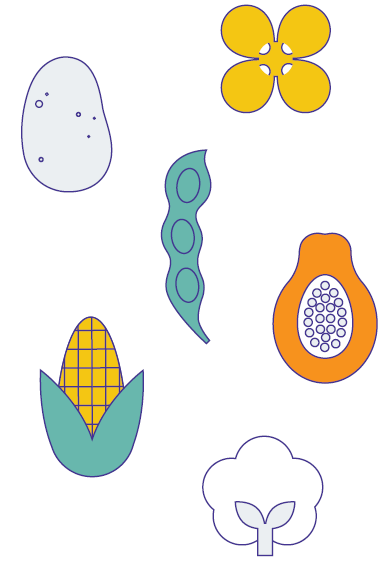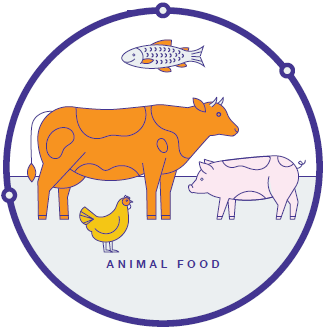GMO Crops, Animal Food, and Beyond
Am I eating foods that come from GMO crops?
It is very likely you are eating foods and food products that are made with ingredients that come from GMO crops. Many GMO crops are used to make ingredients that Americans eat such as cornstarch, corn syrup, corn oil, soybean oil, canola oil, or granulated sugar. A few fresh fruits and vegetables are available in GMO varieties, including potatoes, summer squash, apples, and papayas. Although GMOs are in a lot of the foods we eat, most of the GMO crops grown in the United States are used for animal food.
To make it easier for consumers to know if the foods they eat contain GMO ingredients, the U.S. Department of Agriculture maintains a list of bioengineered foods available throughout the world. Additionally, you will start seeing the “bioengineered” label on some of the foods we eat because of the new National Bioengineered Food Disclosure Standard.
What GMO crops are grown and sold in the United States?
Only a few types of GMO crops are grown in the United States, but some of these GMOs make up a large percentage of the crop grown (e.g., soybeans, corn, sugar beets, canola, and cotton).
In 2018, GMO soybeans made up 94% of all soybeans planted, GMO cotton made up 94% of all cotton planted, and 92% of corn planted was GMO corn.
In 2013, GMO canola made up 95% of canola planted while GMO sugar beets made up 99.9% of all sugar beets harvested.
Most GMO plants are used to make ingredients that are then used in other food products, for example, cornstarch made from GMO corn or sugar made from GMO sugar beets.
Corn:
Corn is the most commonly grown crop in the United States, and most of it is GMO. Most GMO corn is created to resist insect pests or tolerate herbicides. Bacillus thuringiensis (Bt) corn is a GMO corn that produces proteins that are toxic to certain insect pests but not to humans, pets, livestock, or other animals. These are the same types of proteins that organic farmers use to control insect pests, and they do not harm other, beneficial insects such as ladybugs. GMO Bt corn reduces the need for spraying insecticides while still preventing insect damage. While a lot of GMO corn goes into processed foods and drinks, most of it is used to feed livestock, like cows, and poultry, like chickens.
Soybean:
Most soy grown in the United States is GMO soy. Most GMO soy is used for food for animals, predominantly poultry and livestock, and making soybean oil. It is also used as ingredients (lecithin, emulsifiers, and proteins) in processed foods.
Cotton:
GMO cotton was created to be resistant to bollworms and helped revive the Alabama cotton industry. GMO cotton not only provides a reliable source of cotton for the textile industry, it is also used to make cottonseed oil, which is used in packaged foods and in many restaurants for frying. GMO cottonseed meal and hulls are also used in food for animals.
Potato:
Some GMO potatoes were developed to resist insect pests and disease. In addition, some GMO potato varieties have been developed to resist bruising and browning that can occur when potatoes are packaged, stored, and transported, or even cut in your kitchen. While browning does not change the quality of the potato, it often leads to food being unnecessarily thrown away because people mistakenly believe browned food is spoiled.
Papaya:
By the 1990s, ringspot virus disease had nearly wiped out Hawaii’s papaya crop, and in the process almost destroyed the papaya industry in Hawaii. A GMO papaya, named the Rainbow papaya, was created to resist ringspot virus. This GMO saved papaya farming on the Hawaiian Islands.
Summer Squash:
GMO summer squash is resistant to some plant viruses. Squash was one of the first GMOs on the market, but it is not widely grown.
Canola:
GMO canola is used mostly to make cooking oil and margarine. Canola seed meal can also be used in food for animals. Canola oil is used in many packaged foods to improve food consistency. Most GMO canola is resistant to herbicides and helps farmers to more easily control weeds in their fields.
Alfalfa:
GMO alfalfa is primarily used to feed cattle—mostly dairy cows. Most GMO alfalfa is resistant to herbicides, allowing farmers to spray the crops to protect them against destructive weeds that can reduce alfalfa production and lower the nutritional quality of the hay.
Apple:
A few varieties of GMO apples were developed to resist browning after being cut. This helps cut down on food waste, as many consumers think brown apples are spoiled.
Sugar Beet:
Sugar beets are used to make granulated sugar. More than half the granulated sugar packaged for grocery store shelves is made from GMO sugar beets. Because GMO sugar beets are resistant to herbicides, growing GMO sugar beets helps farmers control weeds in their fields.
What about animals that eat food made from GMO crops?
More than 95% of animals used for meat and dairy in the United States eat GMO crops. Independent studies show that there is no difference in how GMO and non-GMO foods affect the health and safety of animals. The DNA in the GMO food does not transfer to the animal that eats it. This means that animals that eat GMO food do not turn into GMOs. If it did, an animal would have the DNA of any food it ate, GMO or not. In other words, cows do not become the grass they eat and chickens don’t become the corn they eat.
Similarly, the DNA from GMO animal food does not make it into the meat, eggs, or milk from the animal. Research shows that foods like eggs, dairy products, and meat that come from animals that eat GMO food are equal in nutritional value, safety, and quality to foods made from animals that eat only non-GMO food.
Learn more about GMO Crops and Food for Animals.
Who makes sure animal food is safe?
The U.S. Food and Drug Administration (FDA) is the primary regulatory agency responsible for ensuring the safety of GMO and non-GMO food for animals. The FDA Center for Veterinary Medicine manages this responsibility. FDA requires that all food for animals, like food for human foods, be safe for animals to eat, be produced under clean conditions, contain no harmful substances, and be accurately labeled.
Are there GMO animals in the food supply?
There soon will be. FDA has approved an application that allows the marketing of the AquAdvantage Salmon, an Atlantic salmon that has been genetically modified to reach an important growth point faster. FDA determined that AquAdvantage Salmon is as safe to eat and as nutritious as non-GMO Atlantic salmon. FDA also found that its approval of the application for this salmon would not significantly impact the U.S. environment.
Are GMOs used to make anything besides food?
When you hear the term “GMO” you probably think of food. However, techniques used to create GMOs are important in creating some medicines as well. In fact, genetic engineering, which is the process used to create GMOs, was first used to make human insulin, a medicine used to treat diabetes. Medicines developed through genetic engineering go through an in-depth FDA approval process. All medicines must be proven to be safe and effective before they are approved for human use. GMOs are also used in the textile industry. Some GMO cotton plants are used to create cotton fiber that is then used to make fabric for clothing and other materials.
How GMOs Are Regulated for Food and Plant Safety in the United States
Science and History of GMOs and Other Food Modification Processes
How GMO Crops Impact Our World




